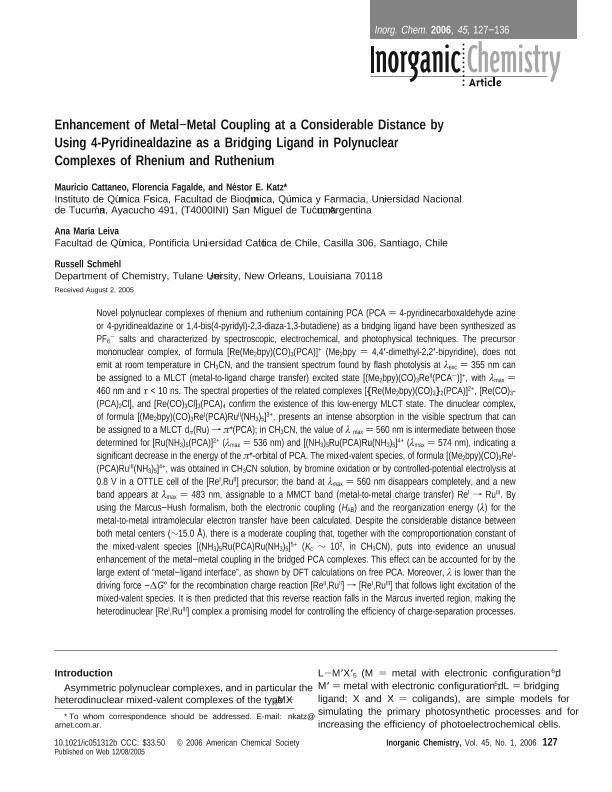Mostrar el registro sencillo del ítem
dc.contributor.author
Cattaneo, Mauricio

dc.contributor.author
Fagalde, Florencia

dc.contributor.author
Katz, Néstor Eduardo

dc.contributor.author
Leiva, Ana María
dc.contributor.author
Schmell, Russell
dc.date.available
2019-10-01T19:45:20Z
dc.date.issued
2006-07
dc.identifier.citation
Cattaneo, Mauricio; Fagalde, Florencia; Katz, Néstor Eduardo; Leiva, Ana María; Schmell, Russell; Enhancement of Metal-Metal Coupling at a Considerable Distance by Using 4-Pyridinealdazine as a Bridging Ligand in Polynuclear Complexes of Rhenium and Ruthenium; American Chemical Society; Inorganic Chemistry; 45; 1; 7-2006; 127-136
dc.identifier.issn
0020-1669
dc.identifier.uri
http://hdl.handle.net/11336/84970
dc.description.abstract
Novel polynuclear complexes of rhenium and ruthenium containing PCA (PCA = 4-pyridinecarboxaldehyde azine or 4-pyridinealdazine or 1,4-bis(4-pyridil)-2,3-diaza-1,3-butadiene) as a bridging ligand have been synthesized as PF6- salts and characterized by spectroscopic, electrochemical and photophysical techniques. The precursor mononuclear complex, of formula [Re(Me2bpy)(CO)3(PCA)]+, (Me2bpy = 4,4´-dimethyl-2,2´-bipyridine), does not emit at room temperature in CH3CN and the transient spectrum found by flash photolysis at lexc = 355 nm can be assigned to a MLCT (metal-to-ligand charge transfer) excited state [(Me2bpy)(CO)3ReII(PCA-)]+, with lmax = 460 nm and t < 10 ns. The spectral properties of the related complexes [{Re(Me2bpy)(CO)3}2(PCA)]2+, [Re(CO)3(PCA)2Cl] and [Re(CO)3Cl]3(PCA)4 confirm the existence of this low-energy MLCT state. The dinuclear complex, of formula [(Me2bpy)(CO)3ReI(PCA)RuII(NH3)5]3+, presents an intense absorption in the visible spectrum that can be assigned to a MLCT dp(Ru) ® p*(PCA); in CH3CN, the value of l max = 560 nm is intermediate between those determined for [Ru(NH3)5(PCA)]2+ (lmax = 536 nm) and [(NH3)5Ru(PCA)Ru(NH3)5]4+ (lmax = 574 nm), indicating a significant decrease in the energy of the p*-orbital of PCA. The mixed valent species, of formula [(Me2bpy)(CO)3ReI(PCA)RuIII(NH3)5]4+, was obtained in CH3CN solution, by bromine oxidation or by controlled potential electrolysis at 0.8 V in a OTTLE cell of the [ReI,RuII] precursor ; the band at lmax = 560 nm disappears completely and a new band appears at lmax = 483 nm , assignable to a MMCT band (metal-to-metal charge transfer) ReI ® RuIII. By using the Marcus-Hush formalism, both the electronic coupling (HAB) and the reorganization energy (l) for the metal-to-metal intramolecular electron transfer have been calculated. In spite of the considerable distance between both metal centers (~ 15.0 Å), there is a moderate coupling that, together with the comproportionation constant of the mixed-valent species [(NH3)5Ru(PCA)Ru(NH3)5]5+ (Kc ~ 102, in CH3CN), put into evidence an unusual enhancement of the metal-metal coupling in the bridged PCA complexes. This effect can be accounted for by the large extent of ?metal-ligand interface?, as shown by DFT calculations on free PCA . Moreover, l is lower than the driving force -DG° for the recombination charge reaction [ReII, RuII ] ® [ReI, RuIII] that follows light excitation of the mixed valent species. It is then predicted that this reverse reaction falls in the Marcus inverted region, making the heterodinuclear [ReI,RuIII] complex a promising model for controlling the efficiency of charge-separation processes.
dc.format
application/pdf
dc.language.iso
eng
dc.publisher
American Chemical Society

dc.rights
info:eu-repo/semantics/openAccess
dc.rights.uri
https://creativecommons.org/licenses/by-nc-sa/2.5/ar/
dc.subject
pca
dc.subject
mixed valent compound
dc.subject
rhenium
dc.subject.classification
Físico-Química, Ciencia de los Polímeros, Electroquímica

dc.subject.classification
Ciencias Químicas

dc.subject.classification
CIENCIAS NATURALES Y EXACTAS

dc.title
Enhancement of Metal-Metal Coupling at a Considerable Distance by Using 4-Pyridinealdazine as a Bridging Ligand in Polynuclear Complexes of Rhenium and Ruthenium
dc.type
info:eu-repo/semantics/article
dc.type
info:ar-repo/semantics/artículo
dc.type
info:eu-repo/semantics/publishedVersion
dc.date.updated
2019-09-30T20:43:32Z
dc.journal.volume
45
dc.journal.number
1
dc.journal.pagination
127-136
dc.journal.pais
Estados Unidos

dc.journal.ciudad
Washington, D.C.
dc.description.fil
Fil: Cattaneo, Mauricio. Consejo Nacional de Investigaciones Científicas y Técnicas. Centro Científico Tecnológico Conicet - Tucumán. Instituto de Química del Noroeste. Universidad Nacional de Tucumán. Facultad de Bioquímica, Química y Farmacia. Instituto de Química del Noroeste; Argentina
dc.description.fil
Fil: Fagalde, Florencia. Consejo Nacional de Investigaciones Científicas y Técnicas. Centro Científico Tecnológico Conicet - Tucumán. Instituto de Química del Noroeste. Universidad Nacional de Tucumán. Facultad de Bioquímica, Química y Farmacia. Instituto de Química del Noroeste; Argentina
dc.description.fil
Fil: Katz, Néstor Eduardo. Consejo Nacional de Investigaciones Científicas y Técnicas. Centro Científico Tecnológico Conicet - Tucumán. Instituto de Química del Noroeste. Universidad Nacional de Tucumán. Facultad de Bioquímica, Química y Farmacia. Instituto de Química del Noroeste; Argentina
dc.description.fil
Fil: Leiva, Ana María. Pontificia Universidad Católica de Chile; Chile
dc.description.fil
Fil: Schmell, Russell. University of Tulane; Estados Unidos
dc.journal.title
Inorganic Chemistry

dc.relation.alternativeid
info:eu-repo/semantics/altIdentifier/url/https://pubs.acs.org/doi/10.1021/ic051312b
dc.relation.alternativeid
info:eu-repo/semantics/altIdentifier/doi/https://dx.doi.org/10.1021/ic051312b
Archivos asociados
